 |
Picks is a monthly sampling of Japan's art scene, offering short reviews of exhibitions at museums and galleries in recent weeks, with an emphasis on contemporary art by young artists. |
 |
 |
 |
1 February 2010 |
 |
| 1 | 2 | |
 |
|
 |
 |
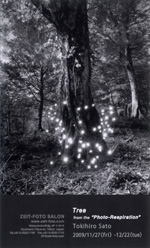 |
|
| Tokihiro Sato: Tree |
| 27 November - 22 December 2009 |
Zeit-Foto Salon
(Tokyo) |
 |
| Since the 1980s Sato has been photographing what might be best described as "light sculptures." These new works feature large trees wrapped in swathes of light that float like will-o'-the-wisps around the trunks. Sato uses a reflective mirror to create the lights; putting an ND filter enabling long exposures on an 8x10 large-format camera lens, he moves around the tree with a mirror in his hand, directing the light signal at the lens. Until now his "Photo-Respiration" series has used man-made objects as a backdrop; this shift to a natural setting evokes an altogether different mood. |
|
|
 |
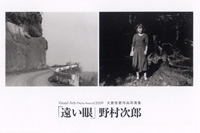 |
|
| Jiro Nomura: Faraway Eyes |
| 1 - 16 December 2009 |
Visual Arts Gallery Tokyo
(Tokyo) |
 |
| Winner of the 2009 Visual Arts Photo Award, Nomura took up photography as a therapeutic activity while recovering from mental illness at his home in the Chichibu mountains. And indeed, his images seem fraught with anxieties and tensions that defy suppression. Even his shots of nondescript mountain roads send a chill up the spine -- the roads suddenly curve away out of sight in the distance ahead. A collection of Nomura's works by the same title as this show has just been published, with suitably austere design by Hitoshi Suzuki. |
|
|
|
|
|
|
 |
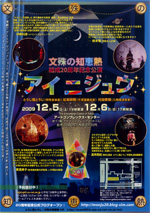 |
|
Monju-no-Chienetsu: Ainiju |
| 5 - 6 December 2009 |
The Artcomplex Center of Tokyo
(Tokyo) |
 |
| The performance group Monju-no-Chienetsu (literally "Manjusri's Teething Fever") celebrated its twentieth anniversary with a piece whose title can be read either as "Love Twenty" in Japanese, or "I Need You" in English. Composed of musician Tojima Toji, artist Akinori Matsumoto, and dancer Seisaku Murata, the group excels at making elaborate puns out of objects, sounds and movements -- in short, wordplay without words. |
|
|
|
|
|
|
|
 |
|
| Takehiko Sugawara |
| 15 November - 27 December 2009 |
Nerima Art Museum
(Tokyo) |
 |
| This retrospective of contemporary Nihonga painter Sugawara brings together some forty works spanning his career from art school days to the present. His motifs range from cityscapes and ruins to natural scenes of cherry blossoms and mountain valleys, but all are executed with rough strokes that generate images of extreme density. Though he employs Nihonga-like motifs and techniques, his work shares much in common with the neo-expressionism of Anselm Kiefer. |
|
|
 |
|
 |

|
|
|
|
|
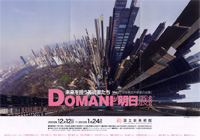 |
|
DOMANI: The Art of Tomorrow 2009 |
12 December 2009 - 24 January 2010
|
The National Art Center, Tokyo
(Tokyo) |
 |
|
Twelve artists sent abroad by the Japanese government's Agency for Cultural Affairs as part of its Overseas Study Program for Artists present their output here. Created in different countries and different styles, it's hard to see the point of exhibiting all these works in the same place. Then again, in this era of administrative reform, perhaps the program felt compelled to display some tangible results. Incidentally, six of the twelve artists chose the U.S. as their destination, with two going to the U.K. and two to Italy.
|
|
|
|
 |
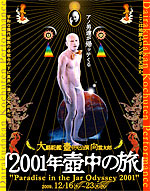 |
|
Dairakudakan: “Paradise in the Jar Odyssey 2001” |
| 16 - 23 December 2009 |
KOCHUTEN
(Tokyo) |
 |
|
Founded by Akaji Maro in 1972, one of Japan's oldest Butoh dance companies, Dairakudakan, continues to produce work that has earned it a bigger following overseas than at home. Their latest production demonstrates just how unfair that is. From the opening scene, in which two men share a passionate embrace amid a blizzard of cherry blossom petals, to an interlude in which the protagonist chops off his own sausage-like appendage before the gatekeeper to Hell, the onslaught of raw, intense images in this cramped theater space foments a chokingly oppressive tension that is absolutely splendid. Maro and his fellow prophets surely deserve more honor in their own land.
|
|
|
|
|
 |
|
 |
|